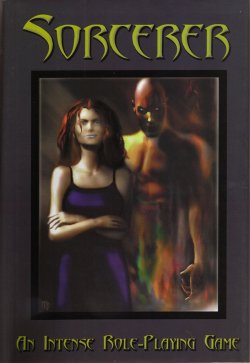
A role-playing game is a game in which players assume the roles of characters in a fictional setting. Players take responsibility for acting out these roles within a narrative, either through literal acting or through a process of structured decision-making regarding character development. Actions taken within many games succeed or fail according to a formal system of rules and guidelines.
A storytelling game is a game where multiple players collaborate on telling a spontaneous story. Usually, each player takes care of one or more characters in the developing story. Some games in the tradition of role-playing games require one participant to take the roles of the various supporting characters, as well as introducing non-character forces, but other systems dispense with this figure and distribute this function among all players.

Wasteland is a role-playing video game developed by Interplay Productions and published by Electronic Arts in 1988. The first installment of the Wasteland series, it is set in a futuristic, post-apocalyptic America destroyed by a nuclear holocaust generations before. Developers originally made the game for the Apple II and it was ported to the Commodore 64 and MS-DOS. It was re-released for Microsoft Windows, OS X, and Linux in 2013 via Steam and GOG.com, and in 2014 via Desura. A remastered version titled Wasteland Remastered was released on February 25, 2020, in honor of the original game's 30th anniversary.

Champions is a role-playing game published by Hero Games designed to simulate a superhero comic book world. It was originally created by George MacDonald and Steve Peterson in collaboration with Rob Bell, Bruce Harlick and Ray Greer. The latest edition of the game uses the sixth edition of the Hero System, as revised by Steve Long, and was written by Aaron Allston. It was released in early 2010.

Pool of Radiance is a role-playing video game developed and published by Strategic Simulations, Inc (SSI) in 1988. It was the first adaptation of TSR's Advanced Dungeons & Dragons (AD&D) fantasy role-playing game for home computers, becoming the first episode in a four-part series of D&D computer adventure games. The other games in the "Gold Box" series used the game engine pioneered in Pool of Radiance, as did later D&D titles such as the Neverwinter Nights online game. Pool of Radiance takes place in the Forgotten Realms fantasy setting, with the action centered in and around the port city of Phlan.

A role-playing video game, commonly referred to as a role-playing game (RPG) or computer role-playing game (CRPG), is a video game genre where the player controls the actions of a character immersed in some well-defined world, usually involving some form of character development by way of recording statistics. Many role-playing video games have origins in tabletop role-playing games and use much of the same terminology, settings, and game mechanics. Other major similarities with pen-and-paper games include developed story-telling and narrative elements, player character development, complexity, as well as replay value and immersion. The electronic medium removes the necessity for a gamemaster and increases combat resolution speed. RPGs have evolved from simple text-based console-window games into visually rich 3D experiences.
Dating sims, or romance simulation games, are a video game subgenre of simulation games with romantic elements. While dating sims share a similar visual presentation as visual novels, they are distinct genres. Dating sims are largely dependent on statistics, while visual novels focus on telling a branching story. Nevertheless, the term "dating sim" has become a generic term for romance-driven games in the West.

Sorcerer is an occult-themed indie role-playing game written by Ron Edwards and published through Adept Press. The game focuses on sorcerers who summon, bind, and interact with demons, powerful non-human entities who work with and against the sorcerer.
Tactical role-playing games, also known as strategy role-playing games and in Japan as simulation RPGs, are a video game genre that combines core elements of role-playing video games with those of tactical strategy video games. The formats of tactical RPGs are much like traditional tabletop role-playing games and strategy games in appearance, pacing, and rule structure. Likewise, early tabletop role-playing games are descended from skirmish wargames such as Chainmail, which were primarily concerned with combat.
A metagame is a game about a game, or an approach to playing a game. A metagame can serve a broad range of purposes, tied to the way a game relates to various aspects of life.

Ronald Edwards is a game designer involved in the indie role-playing game (RPG) community, and a game theorist. He created the Sorcerer role-playing game, the GNS theory of gameplay, and The Big Model. Edwards is also co-founder of The Forge, an online community to support indie RPG design and publication.

The threefold model or GDS theory of roleplaying games is an attempt to distinguish three different goals in roleplaying. In its original formation, these are: Drama, simulation, and game. It was the inspiration for subsequent theories, such as the GNS theory, which retained a three-way division but altered other aspects of the model.

Dogs in the Vineyard is an independently published role-playing game loosely based on the history of the Mormons. It was written by D. Vincent Baker and published by Lumpley Games.

The history of role-playing games begins with an earlier tradition of role-playing, which combined with the rulesets of fantasy wargames in the 1970s to give rise to the modern role-playing game. A role-playing game (RPG) is a type of game in which the participants assume the roles of characters and collaboratively create stories. Traditionally all the participants but one take on characters and determine the actions of their characters based on their characterization and the actions succeed or fail according to a system of rules and guidelines, and one of the participants takes on the role of game master who narrates the story, plays all the non-player characters and determine the challenge rating and the outcome of various actions. Within the rules, the participants may improvise freely; their choices shape the direction and outcome of the games.

Role-playing games (RPGs) have developed specialized terminology. This includes both terminology used within RPGs to describe in-game concepts and terminology used to describe RPGs. Role-playing games also have specialized slang and jargon associated with them.

An indie role-playing game is a role-playing game published outside traditional, "mainstream" means. Varying definitions require that commercial, design, or conceptual elements of the game stay under the control of the creator, or that the game should just be produced outside a corporate environment. Indie role-playing game designers participate in several development communities and game distribution networks. Indie games also grant their own awards committees.

A role-playing game theory is the ludology of role-playing games (RPGs); a study of the topic as a social or artistic phenomenon. RPG theories seek to understand what role-playing games are, how they function, and how the gaming process can be refined in order to improve the experience and produce more useful game products.

A tabletop role-playing game, also known as a pen-and-paper role-playing game, is a classification for a role-playing game (RPG) in which the participants describe their characters' actions through speech, and sometimes movements. Participants determine the actions of their characters based on their characterization, and the actions succeed or fail according to a set formal system of rules and guidelines, usually containing Dice-Rolling. Within the rules, players have the freedom to improvise; their choices shape the direction and outcome of the game.

Spione: Story Now in Cold War Berlin is a role-playing game published by Ron Edwards in 2007.
S/lay w/Me is a role-playing game published by Adept Press in 2009.









